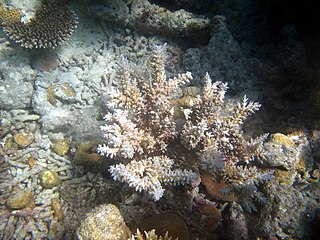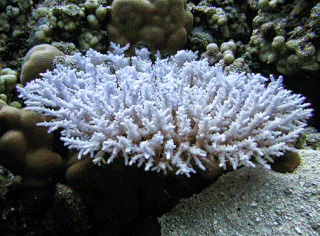
Acropora tenuis is a species of acroporid coral found in the Red Sea, the Gulf of Aden, the southwest, northwest and northern Indian Ocean, the Persian Gulf, the central Indo-Pacific, Australia, Southeast Asia, Japan, the East China Sea and the oceanic west and central Pacific Ocean. It occurs in tropical shallow reefs on upper slopes and in subtidal habitats, at depths of 8 to 20 metres.

Acropora verweyi is a species of acroporid coral found in the southwest and northern Indian Ocean, the central Indo-Pacific, Australia, southeast Asia, Japan, the East China Sea and the oceanic western Pacific Ocean. It is also found in the Philippines, American Samoa, Fiji and Rodrigues. It occurs in tropical shallow reefs on upper slopes, from depths of 2 to 15 metres.
Acropora jacquelineae is a species of acroporid coral found in the eastern Indian Ocean and the central and western Pacific Ocean. It can be found offshore of Indonesia, Malaysia, Papua New Guinea, the Samoan Islands, and the Solomon Islands. It occurs in tropical shallow reefs on reef slopes and flats in subtidal areas, at depths of around between 15 and 35 metres. It was described by Carden Wallace in 1994.
Acropora batunai is a species of acroporid coral that was described by Carden Wallace in 1997. Found in protected, shallow reefs, it occurs in a marine environment at depths of up to 44 m (144 ft). The species is rated as vulnerable on the IUCN Red List, with a decreasing population, and is extremely fragile. It can be found over a large area but, overall, is not common.
Acropora caroliniana is a species of acroporid coral that was first described by Nemenzo in 1976. Found in tropical, shallow reef slopes, it occurs at depths of 5 to 25 m in a marine environment. The species is rated as vulnerable on the IUCN Red List, with a decreasing population. It is rare, but has been found over a large area, and two-thirds of the regions of Indonesia.
Acropora dendrum is a species of acroporid coral that was first described by Bassett-Smith in 1890. Found in tropical, shallow reefs in areas of powerful waves at depths of 5 to 20 m, it is threatened by disease. The species is rated as vulnerable on the IUCN Red List, with a decreasing population. It is not common but found over a large area, and is listed on CITES Appendix II.
Acropora derawanensis is a species of acroporid coral that was first described by Carden Wallace in 1997. Found in tropical, shallow reefs sheltered from the waves in a marine environment, it is found at depths of 10 to 25 m on reef slopes. The species is rated as vulnerable on the IUCN Red List, with a decreasing population. It is not common but found over a large area, and is listed on CITES Appendix II. It is easily damaged.

Acropora echinata is a species of acroporid coral that was first described by Dana in 1846. Found in shallow, tropical, sheltered reefs in marine environments, it is found at depths of 8 to 25 m in clear water. The species is listed as vulnerable on the IUCN Red List, and has a decreasing population. It is not common but found over a large area, and is listed under CITES Appendix II.
Acropora elegans is a species of acroporid coral that was first described by Henri Milne-Edwards in 1860. Found in sheltered, sloping reefs, this species occurs at 30 to 60 m depth. The species is listed as vulnerable on the IUCN Red List, and has a decreasing population. It is not common and has a small range, and is listed under CITES Appendix II. It is more resistant to disease than other Acropora species.
Acropora indonesia is a species of acroporid coral that was first described by Dr Carden Wallace in 1997. Found in marine, tropical, shallow reefs in sheltered flat locations or gentle slopes, it occurs at depths of 10 to 20 m. It is listed as a vulnerable species on the IUCN Red List, and it is thought to have a decreasing population. It is common and found over a large area, and is listed on CITES Appendix II.
Acropora kimbeensis is a species of acroporid coral that was first described by Dr. Carden Wallace in 1999. Found in marine, tropical, shallow reefs usually at depths of 3 to 12 m, but can occur as low as 15 m (49 ft). It is listed as a vulnerable species on the IUCN Red List, and it is thought to have a decreasing population. It is not common and found over a large area, and is listed on CITES Appendix II.
Acropora kirstyae is a species of acroporid coral that was first described by Jen Veron and C. C. Wallace in 1984. Found in marine, tropical, shallow reefs in sheltered areas usually at depths of 10 to 25 m, and also occurs in sheltered lagoons. It is listed as a vulnerable species on the IUCN Red List, and it is thought to have a decreasing population. It is not common and found over a large area, and is listed on CITES Appendix II.
Acropora kosurini is a species of acroporid coral that was first described by C. C. Wallace in 1994. Found in marine, shallow reefs, it occurs at depths of 8 to 20 m. It is listed as a vulnerable species on the IUCN Red List, and it is believed to have a decreasing population. It is rare but found over a large area, and is listed on CITES Appendix II.
Acropora loisetteae is a species of acroporid coral that was first described by C. C. Wallace in 1994. Found in marine, tropical, shallow reefs in sheltered lagoons, it is found at depths between 1 and 30 m. It is listed as vulnerable on the IUCN Red List, and it is thought to have a decreasing population. It is not common but found over a large area, and is listed under CITES Appendix II.
Acropora lokani is a species of acroporid coral that was first described by C. C. Wallace in 1994. Found in marine, shallow reefs and sheltered lagoons, it occurs at depths between 8 and 25 m. It is listed as vulnerable on the IUCN Red List, and is believed to have a decreasing population. It is not common but found over a large area, including in three regions of Indonedia, and is listed under CITES Appendix II.

Acropora microclados is a species of acroporid coral that was first described by Christian Gottfried Ehrenberg in 1834. Found in marine, tropical shallow reefs on the upper slopes, it is found at depths of 5 to 20 m. It is listed as a vulnerable species on the IUCN Red List, and its population is decreasing. It is uncommon but found over a large area, including in five regions of Indonesia, and is classified under CITES Appendix II.
Acropora multiacuta is a species of acroporid coral that was first described by F. Nemenzo in 1967. Found in marine, tropical shallow reefs in lagoons, on rocks or on the tops of reefs, it occurs at depths between 3 and 15 m. It is classed as a vulnerable species on the IUCN Red List, and it has a decreasing population. It is uncommon but found over a large area, including in two regions of Indonesia and the Great Barrier Reef, and is classified under CITES Appendix II.

Acropora paniculata is a species of acroporid coral that was first described by Addison Emery Verrill in 1902. Found in marine, tropical, shallow reefs on the upper slopes, it occurs at depths of between 10 and 35 m. It is classed as a vulnerable species on the IUCN Red List, and it has a decreasing population. It is uncommon but found over a large area, including in five regions of Indonesia, and is classified under CITES Appendix II.
Acropora plumosa is a species of acroporid coral that was first described by Dr. C. C. Wallace and J. Wolstenholme in 1998. Found in marine, tropical, reefs on slopes sheltered from wave action, and on reef walls. It occurs at depths between 10 and 30 m. It is classed as a vulnerable species on the IUCN Red List, and it has a decreasing population. It is not common and found over a large area and is classified under CITES Appendix II.

Acropora polystoma is a species of acroporid coral that was first described by G. Brook in 1891. Found in marine, tropical, reefs on upper slopes where waves are strong, it occurs at depths between 3 and 10 m. It is classed as a vulnerable species on the IUCN Red List, and it has a decreasing population. It is not common and found over a large area and is classified under CITES Appendix II.






